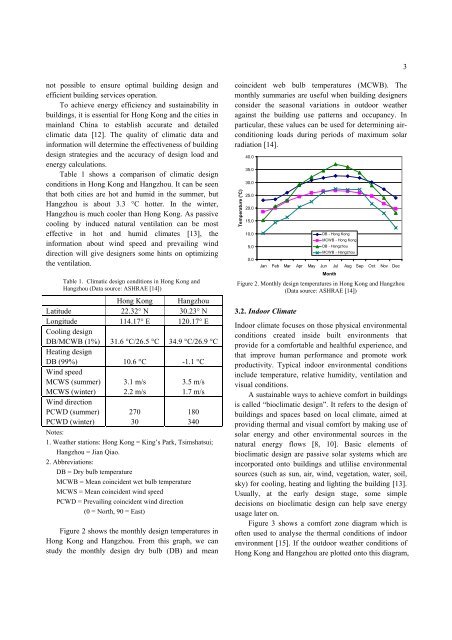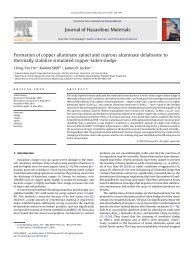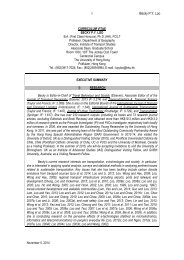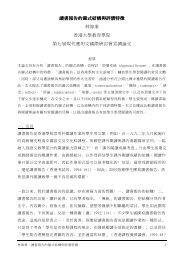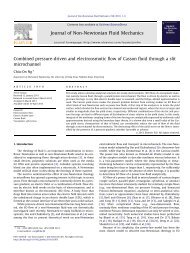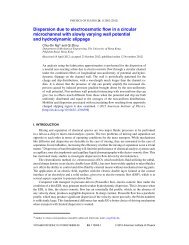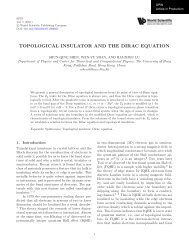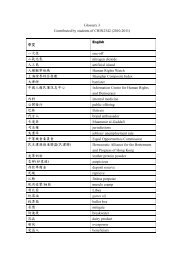sustainable building technologies for hot and humid climates
sustainable building technologies for hot and humid climates
sustainable building technologies for hot and humid climates
Create successful ePaper yourself
Turn your PDF publications into a flip-book with our unique Google optimized e-Paper software.
3<br />
not possible to ensure optimal <strong>building</strong> design <strong>and</strong><br />
efficient <strong>building</strong> services operation.<br />
To achieve energy efficiency <strong>and</strong> sustainability in<br />
<strong>building</strong>s, it is essential <strong>for</strong> Hong Kong <strong>and</strong> the cities in<br />
mainl<strong>and</strong> China to establish accurate <strong>and</strong> detailed<br />
climatic data [12]. The quality of climatic data <strong>and</strong><br />
in<strong>for</strong>mation will determine the effectiveness of <strong>building</strong><br />
design strategies <strong>and</strong> the accuracy of design load <strong>and</strong><br />
energy calculations.<br />
Table 1 shows a comparison of climatic design<br />
conditions in Hong Kong <strong>and</strong> Hangzhou. It can be seen<br />
that both cities are <strong>hot</strong> <strong>and</strong> <strong>humid</strong> in the summer, but<br />
Hangzhou is about 3.3 °C <strong>hot</strong>ter. In the winter,<br />
Hangzhou is much cooler than Hong Kong. As passive<br />
cooling by induced natural ventilation can be most<br />
effective in <strong>hot</strong> <strong>and</strong> <strong>humid</strong> <strong>climates</strong> [13], the<br />
in<strong>for</strong>mation about wind speed <strong>and</strong> prevailing wind<br />
direction will give designers some hints on optimizing<br />
the ventilation.<br />
Table 1. Climatic design conditions in Hong Kong <strong>and</strong><br />
Hangzhou (Data source: ASHRAE [14])<br />
Hong Kong Hangzhou<br />
Latitude 22.32° N 30.23° N<br />
Longitude 114.17° E 120.17° E<br />
Cooling design<br />
DB/MCWB (1%) 31.6 °C/26.5 °C 34.9 °C/26.9 °C<br />
Heating design<br />
DB (99%) 10.6 °C -1.1 °C<br />
Wind speed<br />
MCWS (summer)<br />
MCWS (winter)<br />
3.1 m/s<br />
2.2 m/s<br />
3.5 m/s<br />
1.7 m/s<br />
Wind direction<br />
PCWD (summer)<br />
PCWD (winter)<br />
270<br />
30<br />
180<br />
340<br />
Notes:<br />
1. Weather stations: Hong Kong = King’s Park, Tsimshatsui;<br />
Hangzhou = Jian Qiao.<br />
2. Abbreviations:<br />
DB = Dry bulb temperature<br />
MCWB = Mean coincident wet bulb temperature<br />
MCWS = Mean coincident wind speed<br />
PCWD = Prevailing coincident wind direction<br />
(0 = North, 90 = East)<br />
Figure 2 shows the monthly design temperatures in<br />
Hong Kong <strong>and</strong> Hangzhou. From this graph, we can<br />
study the monthly design dry bulb (DB) <strong>and</strong> mean<br />
coincident web bulb temperatures (MCWB). The<br />
monthly summaries are useful when <strong>building</strong> designers<br />
consider the seasonal variations in outdoor weather<br />
against the <strong>building</strong> use patterns <strong>and</strong> occupancy. In<br />
particular, these values can be used <strong>for</strong> determining airconditioning<br />
loads during periods of maximum solar<br />
radiation [14].<br />
Temperature (°C)<br />
40.0<br />
35.0<br />
30.0<br />
25.0<br />
20.0<br />
15.0<br />
10.0<br />
5.0<br />
0.0<br />
DB - Hong Kong<br />
MCWB - Hong Kong<br />
DB - Hangzhou<br />
MCWB - Hangzhou<br />
Jan Feb Mar Apr May Jun Jul Aug Sep Oct Nov Dec<br />
Month<br />
Figure 2. Monthly design temperatures in Hong Kong <strong>and</strong> Hangzhou<br />
(Data source: ASHRAE [14])<br />
3.2. Indoor Climate<br />
Indoor climate focuses on those physical environmental<br />
conditions created inside built environments that<br />
provide <strong>for</strong> a com<strong>for</strong>table <strong>and</strong> healthful experience, <strong>and</strong><br />
that improve human per<strong>for</strong>mance <strong>and</strong> promote work<br />
productivity. Typical indoor environmental conditions<br />
include temperature, relative <strong>humid</strong>ity, ventilation <strong>and</strong><br />
visual conditions.<br />
A <strong>sustainable</strong> ways to achieve com<strong>for</strong>t in <strong>building</strong>s<br />
is called “bioclimatic design”. It refers to the design of<br />
<strong>building</strong>s <strong>and</strong> spaces based on local climate, aimed at<br />
providing thermal <strong>and</strong> visual com<strong>for</strong>t by making use of<br />
solar energy <strong>and</strong> other environmental sources in the<br />
natural energy flows [8, 10]. Basic elements of<br />
bioclimatic design are passive solar systems which are<br />
incorporated onto <strong>building</strong>s <strong>and</strong> utlilise environmental<br />
sources (such as sun, air, wind, vegetation, water, soil,<br />
sky) <strong>for</strong> cooling, heating <strong>and</strong> lighting the <strong>building</strong> [13].<br />
Usually, at the early design stage, some simple<br />
decisions on bioclimatic design can help save energy<br />
usage later on.<br />
Figure 3 shows a com<strong>for</strong>t zone diagram which is<br />
often used to analyse the thermal conditions of indoor<br />
environment [15]. If the outdoor weather conditions of<br />
Hong Kong <strong>and</strong> Hangzhou are plotted onto this diagram,


